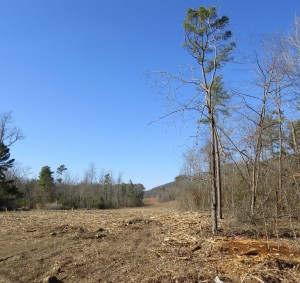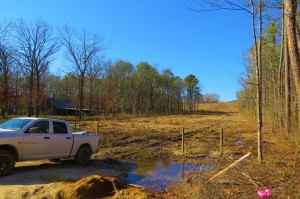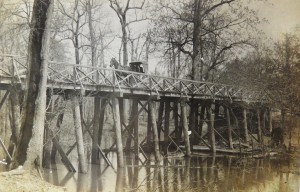Pet Solutions
By Denise White Parkinson
The bypass was doing its job. The concrete divider cupped the ass-end of town, siphoning travelers from highway to strip mall and back. Along the shoulder, a ditch lined with chain link held trash thrown from passing cars. The city’s tacky gray lint screen stretched for miles.
Or was it a seine net? The young woman wondered, gripping the steering wheel. Tractor-trailers thundered by as she took the nearest exit. “An in-seine net,” she punned, smiling down at her silent, shivering passenger. She had spotted the abandoned puppy on the bypass and saw no choice but to rescue it. After all, it was February—spiteful, hateful month. She made for home, somewhat exceeding the speed limit.
“So…you go on a job interview and instead you bring back this fleabag,” Brad said, glancing up from the kitchen table. He was doing their taxes, another reason she hated February. In the silence that followed, an invisible timeline shimmered. The year’s downhill slide from middle-class illusion to flat-broke reality consisted of a miscarriage, layoff, financial crisis, marital conflict, in that order. Documents cluttered the table, details of degradation awaiting official tally.
“I could write a feature on pet rescue,” she blurted. This statement triggered a familiar lecture on insolvency versus freelance journalism. Her husband paced, listing cutbacks necessary for survival of their mortgage. She sat on the couch, daydreaming of dog sweaters and chew toys. “His name is Candide,” she announced, fishing in her purse for a valium.
Tucked in a makeshift bed in the laundry room, Candide slept. The woman left to get puppy food, the job interview forgotten. Her phone buzzed and she answered automatically, “Mobile Media, this is Karen.” A gruff voice growled, “Can we meet at the Walmart by the bypass? We need to talk.”
Recognizing the voice, she said, “Be there in 15 minutes” and hung up. She’d forgotten the old man’s name. Odd; it was barely a year since they last spoke. He was a whistleblower, responsible for the one scoop of her brief journalistic career. Unfortunately, the statewide newspaper (her employer at the time) blacklisted the story. Why did the old man want to talk about a story killed by a paper that no longer employed her? As she drove, Karen recalled the absence of a kill fee, the editor’s insult to injury.
A freezing wind swept the asphalt as she pulled alongside his truck and rolled down the window. The man’s cowboy hat and camo jacket marked him as a good ol’ boy. Karen began apologizing for the unpublished article, but he interrupted.
“No need to say anything, ma’am. I been alive long enough to be your daddy. Somebody way up the chain shut that story down. Nobody wants to talk about a radioactive dump leaking into the river. Nobody but us, I guess.”
He explained that he wanted to show her something at the county landfill, located an hour’s drive to the north. Karen hesitated, not because she didn’t trust him—he was easy enough to trust. It merely seemed a pointless endeavor. Nevertheless, she climbed into the truck and soon the roar of the bypass faded.
The old man droned on while Karen tried to remember his name. As self-appointed watchdog of a leaky dump on the outskirts of town, he was admired in his neighborhood but roundly ignored by local politicians. The man recounted the names of his neighbors, dead from the same cancer that killed his wife, poisoned by radiation spreading underground. “We live in proximity,” he intoned.
Recently, there had come a renewed surge of activity at the old dump. “They started digging and hauling dirt, a dozen dump trucks at a time,” the man said. For three days, the dump trucks came and went nonstop. Curious, the man got in his Ford and followed the parade of radioactive soil. The convoy drove right up to the gates of the county landfill and went inside. This is where he was taking her now.
“What’s so funny?” the cowboy hat tilted. Karen said, “I finally go on a nice drive in the country—to look at a freaking landfill!”
“What you been doing since you left the newspaper?” the man asked. When she replied, “I had a miscarriage,” he fell silent. He wasn’t the type to say “it’s all part of God’s plan”—a phrase Karen loathed as much as February.
After an hour of steep switchbacks over rushing creeks, forest gave way to farm country. They came to a gravel road and turned. An immense clear-cut appeared on the right. “There’s the landfill,” muttered the old man. The muddy place looked deserted. A cloudy horizon of winter-barren trees undulated in all directions.
“What’s that?” Karen said, pointing to a modern factory complex rising just beyond the landfill. The man pulled up to an electric gate next to a sign: “Custom Feed Solutions, LLC.” Tall smokestacks sent thick white plumes over the treetops. Karen grabbed her phone and began photographing the incongruous scene. A truck turned onto the road behind them. “Get us out of here,” she cried.
On the way back to town she plunked away at the phone in search of a website for Custom Feed Solutions. They kept passing through dead zones. A link finally popped up to a parent company called TriUnocor. TriUnocor’s website described a vast network of supply chains. Ingredients, seeds, processed foods, pet and livestock feed, “one-stop shopping for food and agricultural needs—E.U. certified,” it read.
An interactive map showed subsidiaries dotting the U.S. while a banner scrolled TriUnocor’s mission statement: “Serving God’s Kingdom by providing solutions to its nutritional well-being.” They drove into another dead zone and the phone went blank.
“Custom Feed Solutions doesn’t have a website,” Karen said. “It’s a subsidiary of some global wholesaler called TriUnocor.” She began rummaging through her purse for a valium. Back at the parking lot, the man thanked her and she took the back roads home, avoiding the bypass.
In the morning, Brad entered the kitchen to find his wife seated on the floor, coffee in hand, freshly bathed puppy in lap. Now fluffed out, Candide had gone from beige to white and appeared to be a poodle/terrier mix. “I’ll talk to my friend at the Humane Society about getting him a checkup,” Karen said. Brad muttered about payday being a week off and left for work.
Karen spent the morning trying to potty train Candide, spreading layers of newsprint (her former employer) on the laundry room floor. While the puppy napped, she emailed the state environmental agency. Subject line: policy regarding landfill waste. Below her signature she added, “Blog Contributer, the Candide Report.”
A reply came sooner than expected. The media outreach coordinator explained that landfill waste was routinely trucked from one place to another—no big deal. Karen emailed back, asking if Custom Feed Solutions, LLC, and/or the county landfill beside it were monitored for radioactivity. The reply: No. Radiation monitoring was exempt from both sites’ permits. Such records were kept by a different agency, anyway. And what exactly was the Candide Report?
Karen turned off the computer and called her best friend. Meg was single and a trust-funder; she did not want to hear about Karen’s “fuddy-duddy hubby.” But at mention of the dog Meg demanded to come over. Karen looked around at the messy house and stretched on the floor beside Candide.
Several hours later, the friends were midway through a bottle of Mad Housewife. “I can’t believe you’re back on the radioactive dump story,” Meg wailed, cradling Candide. “Why can’t you just write for that lifestyle magazine?”
Karen shuddered. “The editors wanted me to sell ads, too, remember? They sent me to a bunch of upscale boutiques, but I got panic attacks. I would run to the ladies’ room, wash my hands like some OCD loser and leave.”
Meg gasped. “Leave a boutique—without even shopping?” Karen walked to the pantry and flung open the door. “I didn’t say I left empty-handed,” she sighed. The shelf displayed an assortment of elegantly wrapped artisanal soaps, hand lotions, potpourri and so on.
“Oh my God—you’re a klepto!” Meg screamed in delight. By the time Brad got home, the girls were dancing madly to Karen’s collection of vinyl, their duet drowning out the howling dog.
The following weekend, the old man called. He wanted to meet at the dump on the edge of town. Karen didn’t want to go. After all this time the place still gave her the creeps. Even so, under the pretext of getting something for Candide, she went.
The road to the radioactive dump traced a historic trade route along the river. A century before, stagecoaches traveled its tracks and before that, Native American tribes. Settlers had homesteaded along the old road, staking hundreds of acres for farms. Over time, generations of families subdivided the land until an inheritance of trailers and shacks littered the view amid a scattering of nicer properties. The nice homes were outnumbered, Karen noted, passing yards filled with more trash than the bypass.
She spotted the old man’s truck parked near the entrance to the dump. The vast place, hundreds of acres of balding dirt screened by trees, possessed no sign or fencing, just a rusted gate and rustier mailbox nailed to a pole.
“Looky here,” the man said as Karen walked up. He opened the mailbox and pulled out a letter. They examined the envelope, which bore the insignia of the state environmental agency. It was addressed to “General Manager, Mineral Solutions, LLC.”
“Is Mineral Solutions a new owner?” Karen asked; the man didn’t know. The dump had changed hands often and with each sale of the company came a new name. Half a dozen acronyms or more were connected to the maze of corporate ownership.
Oftener, the owners would simply re-name the dump instead of selling it. Research for the story had revealed a common practice: companies that invented new names to dodge regulations or avoid fines, get fresh permits. Promising to research Mineral Solutions, Karen hurried to her car. “I can’t get cell reception out here,” she lied. The man waved forlornly as she drove away. She hated that place.
On payday Brad came home to find another puddle on the kitchen floor. The dog pranced about in a bright red sweater; Karen and Meg were in their cups, reggae blasting. Brad strode to the rear of the house where he had a man-cave in the spare room. The girls ignored him.
By the time Karen woke up, Brad had already left for work. Meg was gone too—the couch unoccupied save for a wine stain and some kibble. The hangover was a bad one. Reaching for the phone, Karen found several messages from the old man. It was too early to hear his voice. Tossing the phone at the wine stain, she staggered to the coffeepot, slipping on a puddle.
Later, Karen stood in the backyard watching Candide sniff around. She could not bring herself to leave the dog outside, despite Brad checking the fence for holes. The house was equipped with a doggy door but it was currently taped shut. Her record with pet rescue was bad. Sipping coffee, she reviewed her disappointing score: baby birds buried in shoeboxes; rodents that met a similar fate; flushed goldfish, aloof stray cats that came and went. She no longer kept houseplants, either. Not since the miscarriage.
Karen was dry-heaving in the bathroom when knocking sounded at the front door. Opening it, she roared “This is not cool!” into the anguished face of the old man. Ignoring her bloodshot eyes, he pleaded, “The dump trucks are back and we should follow ‘em.” Karen slumped in the doorway. “If I go, will you buy breakfast? I’m starving.”
Over a spread of pecan waffles, cheese grits and scrambled eggs, Karen listened as the man spoke of the mysterious dump trucks. She had confessed to a massive hangover that could only be cured by comfort foods. He had responded compassionately, ordering ham, bacon and sausage. Karen buttered a biscuit, fighting back tears of gratitude.
“I been hearing rumors,” the man said. “I went to one of those Patriot Club meetings.” Karen paused in mid-bite. Patriot Clubbers, an embittered bunch of white-haired tax reformers and dyspeptic retirees, believed the worst of any controversy concerning politics and big business. They were usually right. But she distrusted any group whose fundamental anger bordered on spite; a mob indistinguishable from the worst politician.
The man said it was no secret the local Patriot Club chapter was targeting a proposed bond issue. It concerned the radioactive dump and property rights. Millions of tax dollars were at stake. There was to be a referendum. It was all being put to a vote: to buy or not to buy the old radioactive dump.
“Why would the city or county want to own it?” Karen sputtered. “Those companies keep passing it around like a hot potato!” The man nodded, pulling a piece of paper from his jacket and unfolding it on the table. It was an invoice from something called “EnviroTest, Inc.”
Karen read from the list: “Radioactive Bismuth, Thallium, Thorium, Radium 226, Radium 228, Vanadium, Radioactive Lead… total gamma radiation: 65.2 picocuries per gram.” She stared at the paper. “That’s more than ten times the limit.”
The man cleared his throat. “I know a fella, a dump truck driver. He says there’s something not right about this hauling job. They got strange rules, and the men ain’t stupid. Some of that dirt fell off the truck on the way from the radioactive dump to the county landfill. I sent it to a buddy of mine to get tested. This here’s the results.”
“But that still doesn’t explain why…” Karen trailed off. The man produced a different piece of paper, this one clipped from her former employer. The headline, “Dump Site Ideal for Soccer Mecca,” announced a bold new plan to revitalize the area along the historic stagecoach road. A local politician explained, without mentioning the dump or radioactivity, how the site’s “empty acreage” could be redeveloped into a network of soccer fields.
Plenty of room atop the site for a multimillion dollar soccer complex for kids; perfect for the state Brownfields program. Grant funding even guaranteed a liability clause. The article ended with the politician’s quote: “It’s almost too good to be true.”
“Let’s go follow some dump trucks,” Karen murmured. Their stakeout was brief. A line of tri-axle dump trucks emerged one by one past the gate. As they rumbled by, the old man fell in behind and for the next hour Karen dozed. When they neared the county landfill, the man slowed and nudged her awake.
“They’ll be backed up a while at the entrance,” he said. “We’ll drive by in a sec. Have your phone ready to take pictures.” After a few minutes, they continued on.
“Where’s that guy going?” Karen cried as the last dump truck in the convoy steered past the landfill entrance. They followed as it downshifted noisily at the gate of Custom Feed Solutions. “Quick, take a picture,” the man snapped. She got several shots of the dump truck entering the factory yard. The license plate, caked with mud, was unreadable, but the doors were stenciled with the words “God’s will be done.”
“Why did he go in there?” Karen wondered. The man said, “That’s not the first dump truck to do that. They weigh the dump trucks before they take ‘em to a loading dock. You can’t see what happens after that because it’s behind a metal siding.” Karen shivered. “Too bad you don’t have a buddy working for Custom Feed Solutions.” He made no reply.
On the drive back to town they avoided the subject at hand. Instead, Karen confided about her year of unfortunate events. The old man was sympathetic. He talked about his son, a boy Karen’s age who didn’t stay in touch, just drifted from place to place and job to job. “I think he’s on drugs,” the man mused as Karen dug through her purse for a valium.
Karen left the house at dawn, ignoring Candide’s whimpers from the laundry room. Today she would show everybody. She would come home with a job! After driving around town all day filling out applications, she had achieved two things: an empty tank and a splitting headache. The phone buzzed—the husband was sending a rare text. At the next red light, Karen scrolled through the message, humorous and touching. Brad had picked up some dog food “for Candy” and pizza for dinner. He missed her and hoped she was on the way home. Karen smiled for the first time that day.
Merging onto the bypass, she turned up the radio in time to catch a breaking news alert. Something about pets—a pet food recall. A discount brand of puppy chow had poisoned thousands of dogs nationwide. At the announcement of “contaminated mineral additives,” Karen cut the radio, laid on the horn and floored it. One by one, cars pulled over to the shoulder and got the hell out of her way.
“I’m glad you’re home, honey,” Brad called, hurrying to embrace his wife. He stopped and stared at Karen’s purse and keys scattered on the kitchen floor. There was an odd sound coming from the laundry room, a sound he had not heard since last February. He opened the door to find Karen holding the dog, its face and neck spotted bright red. “What’s wrong with the—with Candy?” he stammered.
Karen whispered, “It’s part of God’s plan.” As Brad reached blindly for a blanket and they gently wrapped the tiny, inert body, an invisible curtain seemed to part. Straightening her shoulders, Karen said, “After we bury him, I’ve got a story to write.”
[Author’s note: I have been researching the subject matter within this story for six years. After my journalistic efforts were blacklisted, I re-worked it as a short story for entry in a statewide fiction contest. It was rejected on the grounds that it is NOT fiction, but rather a work of “creative non-fiction.”]




